
Andy Lloyd's Dark Star Blog

Blog 08 (November 2013)
Astrological Clock at Chartres Cathedral
Since visiting Chartres some years ago, work has taken place to restore the clock there to its former glory. On the Dark Star website, I discussed how the clock featured two Suns, and how Chartres was a centre of heretical imagery within the Gothic mediaeval tradition of cathedral building.
The cathedral features many anomalous statues, a remarkable Black Madonna (featuring its own Dark Star imagery) and its famous contemplative maze.
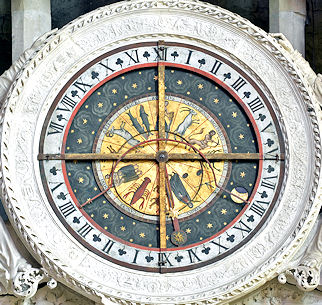
The restoration work has changed the clock, and served to clarify its functionality. A correspondent and researcher, Geoff Stray, recently described to me how the tow Suns featured in the clock allow the viewer to realise a dual feature of the Sun's position in the solar system - both its position along the ecliptic, and the Sun's variable position during the seasons. Geoff kindly set out the clock's features and some examples of how they worked in practice:
"The Sun is not at the centre of the clock. Note that restoration includes a "second sun" on the same "hand" or pointer. The outer one that you have presumed to represent the Dark Star represents the daily position of the sun in the sky. It rotates through 24 hours - 2 x 12 as shown , in which the trefoils represent half-hours. The blue starry circle rotates showing the position of the moon in the zodiac, and the lunar phase, by the changing shadow that covers the moon while it rotates. the zodiac ring rotates at the rate of a sidereal day, compared to the tropical day rotation of the solar pointer.
"The circle you defined as the ecliptic is just that... and the inner sun that slides up and down the pointer shows the position of the sun on the ecliptic as it moves through the zodiac. The red semi-circle between the VIII and IIII represents the position of the horizon at Chartres and indicates the rising and setting times of the Sun at the points where the inner sun crosses horizon. The sliding sun on the pointer also indicates the changing distance from sun to earth over the year, and thereby, the seasons."
Geoff provided the opposite image as one example, explaining it thus:
"Sun at 11.20 p.m; waxing crescent moon in Libra; Sun at the end of Leo, on cusp with Virgo. Sunrise about 4 a.m; sunset about 7.40 pm local time."
I'm most obliged to Geoff for this information. It is absolutely evident that his analysis is correct, as explained on this French website about Chartres Cathedral:
But, saying that, esoteric thinkers have a way of hiding heretical information in plain sight. It remains the case that the pointer depicts two suns. They might both depict the Sun within different contexts, but the original creator of this remarkable Zodiac still chose to show two suns rather than one, which he could easily have done here. Given the broader context of Chartres' mysteries, that still leaves the original meaning of the clock's depiction of two suns as an open question in my mind.
Andy Lloyd, 13th November 2013
Comet ISON and the Dark Star
There's been a lot of hype about Comet ISON on the Internet, and around about now it's a faint object visually that requires binoculars to see it. Daryl wrote to me about the orbital path of the comet, and how is seems to follow a similar line as Nibiru as it tracks through Leo. His analysis stems from work I did about the position of an anomalous star as depicted upon a frieze of Leo created around the time of Christ's birth.
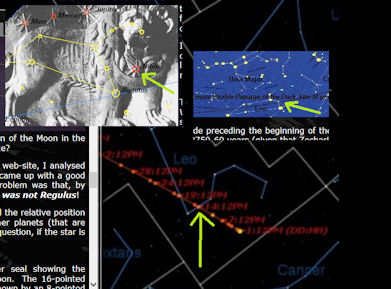
Daryl has incorporated some of the imagery from my website into the image to the right, showing ISON's own movement through Leo. Here's what he wrote:
"I was going back through your dark star pages, mostly because there are just so many visual goodies in there! I happened upon the picture of the lion statue with the extra star. Re-read that section and a few others but wasn't really looking for anything in particular. Later that same evening I decided to get an update on when ISON may be visible to the naked eye. I was absolutely shocked to see that ISON was going to pass through Leo, and that only recently as it passed through Leo was it viewable by the average amateur astronomer.
"Not only has the path been travelled before, but ISON is also coming in at an interesting angle, much like you described a possible dark-star orbital path in one section of your work. Now... if the dark star was to follow this same path, and being about the size of Jupiter or bigger, would it not start glowing and gathering attention as it passed through Leo? Would Leo then not be "glowing", as is mentioned in your section called 'The Reddening"? I would assume a planet the size of Jupiter using ISON's track would be putting on a spectacular show right now!
"Now, if that extra star was just ISON many moons ago, would they not have instead drawn a comet tail instead of a plain old star? I assume by the position of the other three assumed planets, an exact date could be determined of that particular alignment? Would this give any clues to a possible orbital path of the dark star if ISON was merely caught in the Lagrange point along with all the other comets and the one air-burster we had?"
These are certainly fascinating points. The possibility that Nibiru reappeared in our skies around the time of Christ is still one that consider a possibility - that the return of Nibiru was the 'Messiah' that had been keenly awaited for some time, appearing as a royal star, and interpreted as the Messianic Star at Christ's birth. Could ISON be part of that story?
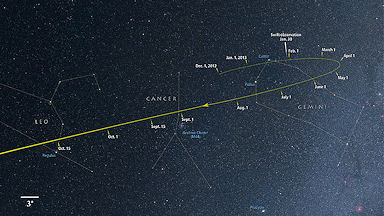
Well, the problem straightaway is that ISON is considered to be on a hyperbolic trajectory. It is a 'new' comet, one that has emerged from the distant Oort Cloud for the first time. It will graze past the Sun before being ejected from the solar system (if it survives the perihelion passage intact, that is). It may become quite bright at some point, although that is by no means certain. But historically, it doesn't seem to have played any part, and is disconnected from any orbital path that the Dark Star may be on. Unless, that is, its plunging towards the Sun might have been triggered by the Dark Star itself, providing us with yet another example of the non-random patterning of long period comet appearances described by Professor Matese et al.
Andy Lloyd, 13th November 2013, with many thanks to Daryl
Syrian Stone Circles Connection
Continuing our discussion of the African stone monuments spread widely across southern African lands, as described by Michael Tellinger and Johan Heine in their book "Temples of the African Gods" (1). In a previous Dark Star piece, I indicated that the formations had a striking parallel with similar ancient structures in war-torn Syria - a connection made by my colleague Lee Covino. Lee has been continuing his research into these ancient structures and has discovered a further connection, this time with the ancient Indus Valley.
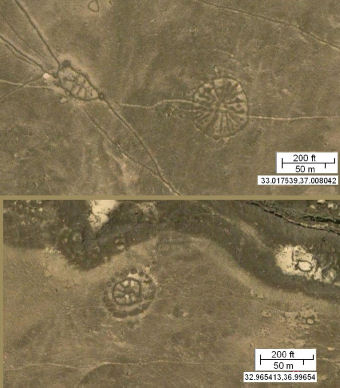
Google Earth
In an academic paper by Mel Copeland, entitled "Similarities between the Syrian stone circles and Thalpan village rock altars - Suggesting a route of the Aryans from Anatolia via Syria to India", (2) the author draws our attention to the remarkable similarities between the stone circles seen from the air in the Syrian countryside, and ancient rock art from Indus valley in Pakistan:
"Stanislas A. Grigoriev’s “Ancient Europeans” (3) offers a theory that the Indo-European migration from the steppe Sintasha and Andronovo cultures (1,800 -1,600 B.C) –from the northern Caucuses and centred perhaps on the southern end of the Caspian Sea, near Tehran - moved through northern Syria and then into India through Bactria. Girgoriev suggests that these people were the ancestors of the Iranians (Persians) and Indus Valley Aryans, whose books the “Avestan” and “Rig Veda” record a common tradition of worship using Soma (Persian Hoama), a sacred, golden drink made from cannabis, which was offered to the gods in ceremonial banquets involving horse and other animal sacrifices.
"If we compare the Syrian stone circles (right, top) with the Thalpan altar rock (right, bottom) we can see a similarity in the use of what would appear to be sun symbols. They have multiple spokes, ranging from a simple cross to eight spokes and more complex designs, with dots and rays around the wheels." (2)
The purpose of the stone circles in South Africa and adjoining African nations remains a mystery. That they should have a counterpart in distant Syria is remarkable indeed, given how ancient these arid structures are. Now, it seems, that geographical separation needs to be extended out to Pakistan's Indus Valley - a region which features its own remarkable ancient civilisation. From a Sitchinite perspective, this is where things get really interesting because the spread of of these circles shows a remarkable parallel with geographical zones described as being central to the Anunnaki's colony on Earth.
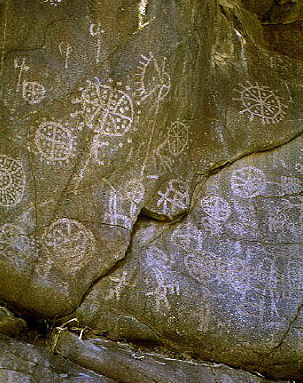
Are these structures simply corrals for animals, or stone bases for buildings whose wooden roofs are long since gone? Or do they involve a more technological solution, as speculated by Michael Tellinger? The extensive nature of these structures is remarkable, even if you just count the southern part of Africa. But their spread across the Middle East to the Indian sub-continent (and possibly even the Caucasus, as hinted by Mel Copeland) puts them into an all-new category of ancient civilisation - one that, curiously, is not currently recognised by mainstream archaeology.
Andy Lloyd, 13th November 2013
1) Michael Tellinger and Johan Heine "Temples of the African Gods: Revealing the Ancient Hidden Ruins of Southern Africa" Zulu Planet Publishers, 2009
2) M. Copeland "Similarities between the Syrian stone circles and Thalpan rock altars- Suggesting a route of the Aryans from Anatolia via Syria to India" 28 June 2013 with thanks to Lee
3) Grigoriev S. “Ancient Indo-Europeans,” 2002, Chelyabinsk Scientific Centre The Ural Branch of the Russian Academy of Sciences (www.eah.uu.ru), uploaded to academia.edu
Vesta's Puzzling Composition
One of the largest asteroids in the solar system, safely ensconced within the asteroid belt between Mars and Jupiter, contains a crustal component that shares a home within the Earth's mantle. Scientists weren't expecting olivine to be found in the crust of Vesta, but rather deeper within it, as the asteroid is large enough to have dragged this mineral into its core during its formation.
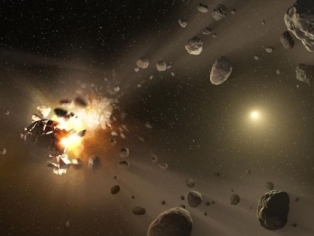
However, its been found in superficial craters instead, causing planetary scientists to scratch their heads:
"Cosmic impacts regularly blast rocks off Vesta. A class of meteorites known as diogenites are thought to come from Vesta's mantle or lower crust, and sometimes possess substantial amounts of a green mineral known as olivine, a major ingredient of Earth's upper mantle. As such, investigators expected to find olivine in places on Vesta where large impacts unearthed deeply buried rocks.
"Now scientists have spotted olivine on Vesta, but not where it was expected it to be. Instead of discovering olivine in Vesta's deep southern craters, they surprisingly found it near shallower northern craters, mixed with the most common type of rock found on Vesta's surface. This suggests olivine might exist within Vesta's crust instead of deeper within its mantle." (1)
The mineral has not been found in the deep basins of the asteroid's southern hemisphere. Scientific theories of the asteroid's formation are becoming more complex in order to reconcile the new data from NASA's Dawn probe.
Could it be part of a massive debris field, strewn across large parts of the surface of Vesta? Could that debris have originated from a primordial collision experienced by Earth, as described by Zecharia Sitchin? This would explain the scenario posed by this proto-planet's unusual composition, although academic astronomers won't really want to consider such an outlandish possibility! After all, this involves a collision that took place some 3.9 billion years ago when the Earth, according to Sitchin, was in the asteroid belt's current location. This is not acceptable to science, but the facts may well fit with the evidence, nonetheless.
Let's consider these points:
Vesta must have already formed when it was hit by Earth's debris, otherwise olivine would have been consumed within Vesta during the formation process.
Any catastrophic event involving Earth must have taken place after Vesta formed.
The debris field associated with that event was then vast enough to cover large parts of the surface of an asteroid belt object, meaning that the crustal composition of the asteroid was contaminated by olivine from the Earth's ruptured mantle in a way that its deeper basins were not.
This is not beyond the realm of possibility, I think, and provides a simpler solution to the problem posed by Dawn.
Andy Lloyd, 13th November 2013, with thanks to Lee
Reference:
1) Choi, C. "Mystery of Huge Asteroid Vesta's Formation Deepens" 6 November 2013
Star and Crescent
Some years ago, I wrote extensively about Roman coins which depicted the Star and Crescent symbol. I wondered whether this symbolism might be connected to the appearance of a Messianic Star during the Graeco-Roman era. This symbolism later became one of the major religious symbols of our time, becoming associated with Islam. But where did it come from? I wondered whether it was part of a long-standing tradition going way back to Sumerian times - a tradition which speaks of esoteric lore connected to Nibiru.
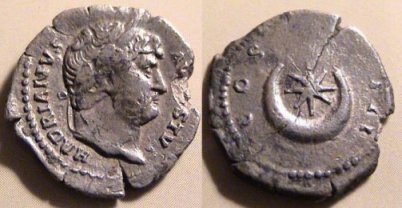
To be honest, this strand of research is something I'd forgotten about over time, but a recent correspondent (known to me only as 'D') sent me the following extract explaining the origins of the Star and Crescent symbol. And guess what? It does indeed go back to the Sumerians...
"The star and crescent appear in combination in finds from in and around ancient Palestine. It has been associated with the Moabites (14th or early 13th – 6th century BC[5]), as the symbol or symbols appear on what are thought to be Moabite name seals. (2) Crescents appearing together with a star or stars are a common feature of Sumerian iconography, the crescent usually being associated with the moon god Sin(Nanna to the Sumerians) and the star (often identified as Venus) with Ishtar (Inanna to the Sumerians). However, in this context, there is a third element often seen, that being the sun disk of Shamash.
"Academic discussion of a star or stars together with crescents in Sumerian representations does not always clearly indicate if they appear in isolation (the "star and crescent" as such) or as part of a triad of symbols, "the three celestial emblems, the sun disk of Shamash (Utu to the Sumerians), the crescent of Sin (Nanna), and the star of Ishtar (Inanna to the Sumerians)" (3) or "the crescent of Sin (the moon god), the star of Ishtar and the ray of Shamash". (4) Nevertheless, later use of the star and crescent by the Parthians, and other Iranian dynasties is often traced to earlier use in Mesopotamia." (1)
Andy Lloyd, 13th November 2013
References:
1) 'Star and Crescent' entry on ask.com with thanks to 'D'
2) Othmar Keel, Christoph Uehlinger "Gods, Goddesses, and Images of God in Ancient Israel" Fortress Press, 1998, p322
![]() Gods, Goddesses, and Images of God in Ancient Israel
Gods, Goddesses, and Images of God in Ancient Israel
3) Irving L. Finkel, Markham J. Geller, "Sumerian Gods and Their Representations", Styx, 1997, p71
![]() Sumerian Gods and Their Representation
Sumerian Gods and Their Representation
4) André Parrot, Sumer: The Dawn of Art, Golden Press, 1961
Gold Nanoparticles
Mark sent me a set of links regarding the use of gold in nanotechnology, particularly for potential medicinal uses. The following links demonstrate the use of gold in exotic, nanotechnology products which may lead to scientific and technological breakthroughs.
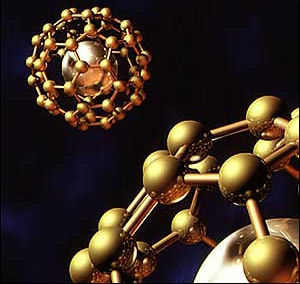
It seems like early days yet, but there only needs to be one big breakthrough for people to realise how gold might take on central importance in advanced, modern technology of the future (especially as biotech catalysts). And from there, the Anunnaki's interest in gold would become very clear indeed. After all, many of these advances are in the field of medicine. Medical research scientists are incorporating gold into nanoparticles with biotechnological applications. Often, these are for life saving treatments for cancers. If we take seriously Zecharia Sitchin's claim that the Anunnaki extended their life-spans essentially indefinitely through such means, then it is not a huge jump to see how. Perhaps gold is the key to longevity after all, but in a far more technologically sophisticated way than suggested by the proponents of 'monatomic gold'.
Here are examples of applications in the medicine:
Gold nanoclusters: superbugs old antibiotics:
Gold nanostar cancer drug delivery:
Nanoparticles destroying cancer cell:
Early lung cancer detection:
Gold nanocages cancer photothermal treatment:
Gold nanowires heart patch:
Golod nanospheres search out and 'cook 'cancer cells:
Here are applications in solar power and other spheres:
Gold nanoparticles boost solar cell efficiency:
Glowing trees using gold nanoparticles:
Gold nanoparticles turn light into electrical current:
Andy Lloyd, 13 November 2013 and updated 11 November 2021, with thanks to Mark

You can keep informed of updates by following me on Twitter:
![]()
Or like my Facebook Page: https://www.facebook.com/darkstarandylloyd